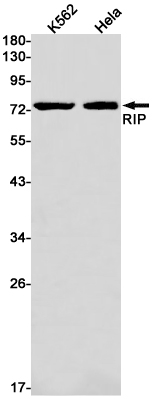
| WB | 1/500-1/1000 | Human,Mouse,Rat |
| IF | 咨询技术 | Human,Mouse,Rat |
| IHC | 咨询技术 | Human,Mouse,Rat |
| ICC | 技术咨询 | Human,Mouse,Rat |
| FCM | 咨询技术 | Human,Mouse,Rat |
| Elisa | 咨询技术 | Human,Mouse,Rat |
| Aliases | RIPK1; Cell death protein RIP; RIP1; RIP; RIP-1; Rinp |
| Entrez GeneID | 8737 |
| WB Predicted band size | Calculated MW: 76 kDa; Observed MW: 76 kDa |
| Host/Isotype | Rabbit IgG |
| Antibody Type | Primary antibody |
| Storage | Store at 4°C short term. Aliquot and store at -20°C long term. Avoid freeze/thaw cycles. |
| Species Reactivity | Human |
| Immunogen | Recombinant protein of human RIP |
| Formulation | Purified antibody in TBS with 0.05% sodium azide,0.05%BSA and 50% glycerol. |
+ +
以下是关于RIP抗体的3篇代表性文献及其摘要概括:
---
1. **文献名称**:*Identification of RIP1 kinase as a specific cellular target of necroptosis*
**作者**:Degterev, A. et al.
**摘要**:该研究通过开发特异性RIP1(Receptor-interacting protein 1)抗体,揭示了其在坏死性凋亡(necroptosis)信号通路中的关键作用。实验表明,RIP1与坏死复合体(necrosome)的形成直接相关,并验证了该抗体在检测内源性RIP1激活状态中的应用。
---
2. **文献名称**:*RIP3. an energy metabolism regulator that switches TNF-induced cell death from apoptosis to necrosis*
**作者**:He, S. et al.
**摘要**:本文利用RIP3特异性抗体,阐明了RIP3通过调控能量代谢决定细胞死亡方式(凋亡或坏死)的机制。研究发现,RIP3缺失的细胞无法形成坏死复合体,且抗体检测证实其与RIP1的相互作用依赖于特定磷酸化事件。
---
3. **文献名称**:*Functional complementation between FADD and RIP1 in embryogenesis and NF-κB signaling*
**作者**:Kelliher, M.A. et al.
**摘要**:通过RIP1基因敲除模型及相应抗体的应用,研究揭示了RIP1在胚胎发育和NF-κB信号通路中的双重功能。免疫共沉淀实验表明,RIP1抗体可特异性识别其与死亡结构域蛋白(如TRADD)的结合,为RIP1在炎症反应中的作用提供证据。
---
4. **文献名称**:*RIP1 suppresses innate immune necrotic as well as apoptotic cell death during mammalian development*
**作者**:Dillon, C.P. et al.
**摘要**:该研究利用条件性RIP1敲除小鼠及特异性抗体,证明RIP1通过抑制坏死和凋亡双重途径维持组织稳态。Western blot和免疫组化结果显示,RIP1缺失导致自发性的细胞死亡,提示其在先天免疫中的保护作用。
---
这些文献涵盖了RIP抗体在机制研究、信号通路解析及疾病模型中的应用,涉及凋亡、坏死性凋亡和免疫调控等多个方向。如需具体文章链接或补充更多文献,可进一步说明需求。
×